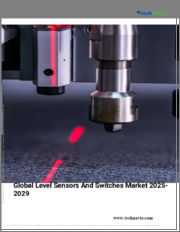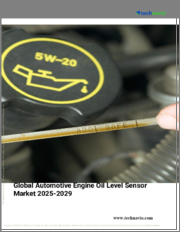
|
시장보고서
상품코드
1587648
세계의 레벨 센서 시장 예측 : 유형별, 기술별, 용도별, 최종 사용자별, 지역별 분석(-2030년)Level Sensors Market Forecasts to 2030 - Global Analysis By Type (Continuous Level Sensing, Point Level Sensing, Interface Level Sensing and Other Types), Technology, Application, End User and By Geography |
||||||
Stratistics MRC에 따르면 세계의 레벨 센서 시장은 2024년에 55억 달러로 추정되고, 예측 기간 동안 CAGR 8.5%로 성장할 전망이며, 2030년에는 89억 달러에 이를 전망입니다.
레벨 센서는 용기나 환경 내의 액체, 미립자 물질, 물질의 레벨을 측정 및 감시하기 위해 사용되는 장치입니다. 레벨 센서는 물질의 레벨이 특정 포인트보다 위인지 아래인지를 검출하는 포인트 레벨 센서와 물질의 레벨에 관한 실시간 데이터를 범위 전체에서 제공하는 연속 레벨 센서로 구분됩니다. 이러한 센서는 정전용량 방식, 초음파 방식, 광학 방식 등의 기술을 사용하여 물리적인 측정치를 전기 신호로 변환하고 모니터링 및 제어를 목적으로 합니다.
자동화에 대한 수요 증가
산업 자동화의 상승으로 효율적인 프로세스 제어 및 모니터링을 위한 고급 레벨 센싱 기술에 대한 수요가 급증하고 있습니다. 산업 프로세스에서 IoT와 스마트 기술의 통합은 이러한 센서의 기능을 강화하고 더 나은 의사결정과 운영 효율을 위한 실시간 데이터를 제공하고 있습니다. 그 때문에, 무선 통신 가능한 스마트 센서에 대한 수요의 고조도 시장 성장의 원동력이 되고 있습니다.
높은 초기 투자 비용
신흥기업과 중소기업은 초기 비용이 비싸기 때문에 첨단 수준의 센서 기술에 대한 투자를 자제하고 있습니다. 많은 기업, 특히 재정이 어려운 기업은 보다 저렴한 선택지를 선택하거나 구입을 미루거나 합니다. 기업은 초기 비용 회수에 관한 재무적 우려로 신기술 및 제품 개량에 대한 투자를 주저할 가능성이 있으며, 이로 인해 기술 진보가 저해되고 보다 효율적인 레벨 센싱 솔루션 도입이 제한되기 때문에 시장 침투가 저하되어 성장이 정체되게 됩니다.
산업 안전 및 환경 모니터링 요구 증가
석유 및 가스, 화학제조, 폐수처리 등의 위험한 산업에서는 엄격한 규제 요건으로 인해 레벨 센서의 채용이 증가하고 있습니다. 이러한 센서는 유체 레벨의 감시, 유출 방지, 안전 기준의 확보에 필수적입니다. 또한, 조직은 오버플로우, 누출, 재료 부족 등의 위험을 줄이기 위해 기술에 투자하고 있으며, 안전 문화를 촉진하고 제조업체에게 첨단 센서 기술 개발을 촉진하고 시장 존재감을 증가시키고 있습니다.
대체 레벨 측정 기술
기존의 접촉식 레벨 센서는 레이더나 초음파 센서와 같은 비접촉식 레벨 측정 기술이 보급됨에 따라 덜 사용되고 있습니다. 이러한 대체 기술은 보다 높은 정확도를 제공하고 유지보수의 필요성이 적고 환경 조건의 영향을 받기 어려우므로 다양한 용도로 보다 선호되고 있습니다. 그 결과 기존 레벨 센서 제조업체는 경쟁 심화와 싸워야 하며 시장 점유율이 떨어질 수 있습니다.
COVID-19의 영향 :
COVID-19의 대유행은 당초, 조업 정지나 산업 활동의 저하에 의해 레벨 센서 시장을 혼란시켜, 특히 제조업이나 에너지 분야에서 수요 둔화로 이어졌습니다. 이러한 변화는 비접촉 솔루션과 IoT 통합을 지원하는 레벨 센서의 채용을 가속화했습니다. 결국, 팬데믹은 과제를 가져오는 한편, 레벨 센서 시장에서의 회복력과 혁신의 중요성을 부각시켜, 장래의 성장에 대한 길을 열었습니다.
예측 기간 동안 연속 레벨 센싱 부문이 최대가 될 것으로 예상됩니다.
연속 레벨 센서는 액체 및 고체 레벨을 지속적으로 측정하여 실시간 모니터링을 보장하기 때문에 예측 기간 동안 연속 레벨 센싱 부문이 시장 점유율을 독점할 것으로 예상됩니다. 석유 및 가스, 수처리, 식품 가공 등 정확한 레벨 제어가 업무의 유효성과 안전성에 필수적인 분야에서는 이 능력이 필수적입니다. 지속적인 레벨 감시는 프로세스 관리를 개선하고 오버플로나 드라이런 시나리오의 가능성을 저하시킵니다.
예측 기간 동안 탱크 레벨 모니터링 분야의 CAGR이 가장 높을 것으로 예상됩니다.
탱크 레벨 모니터링 분야는 화학, 식품, 석유, 가스 등의 분야에 필수적인 액면 레벨에 관한 실시간 정보를 제공함으로써 업무 효율을 향상시키는 것으로 예측 기간 중에 대폭적인 성장이 예상됩니다. 정확한 모니터링은 생산 공정을 최적화하고, 낭비를 없애고, 결함이 있는 제품과 오버플로를 피하는 데 도움이 됩니다. 정확한 레벨 측정의 필요성이 높아지고 있는 것이 고도의 레벨 센서 수요의 직접적인 원동력이 되고 있습니다.
최대 공유 지역 :
북미는 환경 규제와 지속가능성에 대한 관심이 높아짐에 따라 예측 기간 동안 최대 시장 점유율을 차지할 것으로 예상됩니다. 유럽 기업들이 폐기물 관리와 에너지 효율에 중점을 두고 있기 때문에 규제 규범을 준수하는 고도의 레벨 센싱 기술 수요가 높습니다. IoT 대응 센서의 채용은, 동지역의 인더스트리 4.0과 디지털 변혁에의 대처에 의해서도 가속하고 있습니다.
CAGR이 가장 높은 지역 :
아시아태평양은 급속한 도시화, 산업화, 인프라 지출 증가로 예측 기간 동안 가장 높은 성장률을 나타낼 것으로 예상됩니다. 중국, 인도, 일본은 모두 제조업이 활발하기 때문에 아시아 태평양 지역에서 빠르게 특히 화학, 식음료, 수처리 등의 산업에서 지속 가능한 관행과 신재생 에너지를 지원하는 정부 프로그램으로 인해 이 수요는 더욱 증가하고 있으며,이 지역 시장 성장을 가속화하고 있습니다.
무료 주문을 받아서 만드는 서비스 :
이 보고서를 구독하는 고객은 다음 무료 맞춤설정 옵션 중 하나를 사용할 수 있습니다.
- 기업 프로파일
- 추가 시장 기업의 종합적 프로파일링(3개사까지)
- 주요 기업의 SWOT 분석(3개사까지)
- 지역 세분화
- 고객의 관심에 응한 주요국 시장 추계, 예측 및 CAGR(주 : 타당성 확인에 따름)
- 경쟁 벤치마킹
- 제품 포트폴리오, 지리적 존재, 전략적 제휴에 기반한 주요 기업 벤치마킹
목차
제1장 주요 요약
제2장 서문
- 개요
- 이해관계자
- 조사 범위
- 조사 방법
- 데이터 마이닝
- 데이터 분석
- 데이터 검증
- 조사 접근
- 조사 정보원
- 1차 조사 정보원
- 2차 조사 정보원
- 전제조건
제3장 시장 동향 분석
- 성장 촉진요인
- 억제요인
- 기회
- 위협
- 기술 분석
- 용도 분석
- 최종 사용자 분석
- 신흥 시장
- COVID-19의 영향
제4장 Porter's Five Forces 분석
- 공급기업의 협상력
- 구매자의 협상력
- 대체품의 위협
- 신규 진입업자의 위협
- 경쟁 기업간 경쟁 관계
제5장 세계의 레벨 센서 시장 : 유형별
- 연속 레벨 센싱
- 포인트 레벨 센싱
- 인터페이스 레벨 센싱
- 기타 유형
제6장 세계의 레벨 센서 시장 : 기술별
- 커패시턴스
- 전도성
- 플로트 레벨 센서
- 마이크로파 및 레이더
- 광학
- 공압
- 초음파
- 진동 포인트
- 기타 기술
제7장 세계의 레벨 센서 시장 : 용도별
- 탱크 레벨 모니터링
- 재고 관리
- 누설 검출
- 유량과 흐름의 측정
- 물 및 폐수 처리
- 기타 용도
제8장 세계의 레벨 센서 시장 : 최종 사용자별
- 석유 및 가스
- 화학약품
- 의약품
- 농업
- 자동차
- 음식
- 기타 최종 사용자
제9장 세계의 레벨 센서 시장 : 지역별
- 북미
- 미국
- 캐나다
- 멕시코
- 유럽
- 독일
- 영국
- 이탈리아
- 프랑스
- 스페인
- 기타 유럽
- 아시아태평양
- 일본
- 중국
- 인도
- 호주
- 뉴질랜드
- 한국
- 기타 아시아태평양
- 남미
- 아르헨티나
- 브라질
- 칠레
- 기타 남미
- 중동 및 아프리카
- 사우디아라비아
- 아랍에미리트(UAE)
- 카타르
- 남아프리카
- 기타 중동 및 아프리카
제10장 주요 발전
- 계약, 파트너십, 협업 및 합작투자(JV)
- 인수 및 합병
- 신제품 발매
- 사업 확대
- 기타 주요 전략
제11장 기업 프로파일링
- ABB Ltd
- AMETEK. Inc.
- Baumer Group
- BinMaster Inc.
- Emerson Electric Co.
- Endress Hauser AG
- First Sensor AG
- Georg Fischer AG
- Honeywell International Inc
- MTS System Corporation
- Senix Corporation
- Sick AG
- Siemens AG
- TE Connectivity Ltd
- Vega Grieshaber KG
According to Stratistics MRC, the Global Level Sensors Market is accounted for $5.5 billion in 2024 and is expected to reach $8.9 billion by 2030 growing at a CAGR of 8.5% during the forecast period. Level sensors are devices used to measure and monitor the level of liquids, granular materials, or substances within a container or environment. They are divided into point level sensors, which detect a substance's level above or below a specific point, and continuous level sensors, which provide real-time data on the substance's level throughout a range. These sensors use technologies like capacitive, ultrasonic, and optical methods to convert physical measurements into electrical signals for monitoring and control purposes.
Market Dynamics:
Driver:
Increasing demand for automation
The rise in industrial automation is driving a surge in the demand for advanced level sensing technologies for efficient process control and monitoring. The integration of IoT and smart technologies in industrial processes is enhancing the capabilities of these sensors, providing real-time data for better decision-making and operational efficiency. Thus, the increasing demand for wirelessly communicating smart sensors is also driving market growth.
Restraint:
High initial investment costs
Startups and smaller businesses are discouraged from investing in advanced level sensor technology due to their high upfront expenses. Many businesses, especially those with tight finances, would choose less expensive options or put off making purchases. As companies may be hesitant to invest in new technologies or product improvements due to financial concerns about recouping initial costs, thereby stifling technological advancements and limiting the introduction of more efficient level sensing solutions which would reduce market penetration and stall growth.
Opportunity:
Growing need for industrial safety and environmental monitoring
The adoption of level sensors in hazardous industries like oil and gas, chemical manufacturing, and wastewater treatment is on the rise due to strict regulatory requirements. These sensors are crucial for monitoring fluid levels, preventing spills, and ensuring safety standards. Additionally, organizations are investing in technology to mitigate risks like overflow, leaks, and material shortages, promoting a culture of safety and encouraging manufacturers to develop advanced sensor technologies propelling the markets presence.
Threat:
Alternative level measurement technologies
Traditional contact-based level sensors are becoming less and less used as non-contact level measuring technologies like radar and ultrasonic sensors gain traction. These substitutes are more desirable for a variety of applications since they frequently offer more precision, need less upkeep, and are less impacted by environmental conditions. Traditional level sensor producers must contend with heightened competition as a result, which may reduce their market share.
Covid-19 Impact:
The COVID-19 pandemic initially disrupted the level sensors market due to lockdowns and reduced industrial activities, leading to a slowdown in demand, particularly in manufacturing and energy sectors. This shift accelerated the adoption of level sensors that support contactless solutions and IoT integration. Ultimately, while the pandemic posed challenges, it also highlighted the importance of resilience and innovation in the level sensors market, paving the way for future growth.
The continuous level sensing segment is expected to be the largest during the forecast period
Over the forecasted timeframe, the continuous level sensing segment is anticipated to dominate the market shar because continuous level sensors ensure real-time monitoring by continuously measuring the levels of liquids and solids. For sectors like oil and gas, water treatment, and food processing, where accurate level control is critical to operational effectiveness and safety, this capacity is vital. Continuous level monitoring improves process management and lowers the possibility of overflows or dry-running scenarios.
The tank level monitoring segment is expected to have the highest CAGR during the forecast period
The tank level monitoring segment is projected to witness substantial growth during the projection period as these systems improve operational efficiency by giving real-time information on liquid levels, which is essential for sectors including chemicals, food and beverage, and oil and gas. Accurate monitoring optimizes production processes, cuts waste, and helps avoid shortages and overflows. The increasing necessity for accurate level measurement is a direct driver of the demand for sophisticated level sensors.
Region with largest share:
The North America region is projected to account for the largest market share during the forecast period owing to increasing focus on environmental regulations and sustainability. Advanced level sensing technologies that adhere to regulatory norms are in high demand as European firms place a greater emphasis on waste management and energy efficiency. IoT-enabled sensor adoption is also accelerated by the region's dedication to Industry 4.0 and digital transformation.
Region with highest CAGR:
The Asia Pacific region is expected to register the highest growth rate over the forecast period because of its quick urbanization, industrialization, and rising infrastructure spending. China, India, and Japan are all seeing rapid expansion in the Asia-Pacific region as a result of their thriving manufacturing sectors. This demand is further increased by government programs supporting sustainable practices and renewable energy, particularly in industries like chemicals, food and beverage, and water treatment which accelerates the market growth in this region.
Key players in the market
Some of the key players in Level Sensors Market include ABB Ltd , AMETEK. Inc., Baumer Group, BinMaster Inc., Emerson Electric Co., Endress + Hauser AG, First Sensor AG, Georg Fischer AG, Honeywell International Inc, MTS System Corporation, Senix Corporation , Sick AG, Siemens AG, TE Connectivity Ltd and Vega Grieshaber KG.
Key Developments:
In September 2024, Emerson expanded its NI(TM) USB data acquisition (DAQ) product line with the new NI mioDAQ device. To help engineers meet the increasing demand to improve quality and reduce time-to-market when developing advanced electronic technologies.
In August 2024, ABB announced that it has signed an agreement to acquire Fodisch Group, a leading developer of advanced measurement and analytical solutions for the energy and industrial sectors.
In May 2024, ABB announced it has signed an agreement to acquire Siemens' Wiring Accessories business in China. The acquisition will broaden ABB's market reach and complement its regional customer offering within smart buildings.
Types Covered:
- Continuous Level Sensing
- Point Level Sensing
- Interface Level Sensing
- Other Types
Technologies Covered:
- Capacitance
- Conductive
- Float Level Sensor
- Microwave/Radar
- Optical
- Pneumatic
- Ultrasonic
- Vibrating Point
- Other Technologies
Applications Covered:
- Tank Level Monitoring
- Inventory Management
- Leak Detection
- Flow & Stream Measurement
- Water & Wastewater Treatment
- Other Applications
End Users Covered:
- Oil & Gas
- Chemicals
- Pharmaceuticals
- Agriculture
- Automotive
- Food & Beverage
- Other End Users
Regions Covered:
- North America
- US
- Canada
- Mexico
- Europe
- Germany
- UK
- Italy
- France
- Spain
- Rest of Europe
- Asia Pacific
- Japan
- China
- India
- Australia
- New Zealand
- South Korea
- Rest of Asia Pacific
- South America
- Argentina
- Brazil
- Chile
- Rest of South America
- Middle East & Africa
- Saudi Arabia
- UAE
- Qatar
- South Africa
- Rest of Middle East & Africa
What our report offers:
- Market share assessments for the regional and country-level segments
- Strategic recommendations for the new entrants
- Covers Market data for the years 2022, 2023, 2024, 2026, and 2030
- Market Trends (Drivers, Constraints, Opportunities, Threats, Challenges, Investment Opportunities, and recommendations)
- Strategic recommendations in key business segments based on the market estimations
- Competitive landscaping mapping the key common trends
- Company profiling with detailed strategies, financials, and recent developments
- Supply chain trends mapping the latest technological advancements
Free Customization Offerings:
All the customers of this report will be entitled to receive one of the following free customization options:
- Company Profiling
- Comprehensive profiling of additional market players (up to 3)
- SWOT Analysis of key players (up to 3)
- Regional Segmentation
- Market estimations, Forecasts and CAGR of any prominent country as per the client's interest (Note: Depends on feasibility check)
- Competitive Benchmarking
- Benchmarking of key players based on product portfolio, geographical presence, and strategic alliances
Table of Contents
1 Executive Summary
2 Preface
- 2.1 Abstract
- 2.2 Stake Holders
- 2.3 Research Scope
- 2.4 Research Methodology
- 2.4.1 Data Mining
- 2.4.2 Data Analysis
- 2.4.3 Data Validation
- 2.4.4 Research Approach
- 2.5 Research Sources
- 2.5.1 Primary Research Sources
- 2.5.2 Secondary Research Sources
- 2.5.3 Assumptions
3 Market Trend Analysis
- 3.1 Introduction
- 3.2 Drivers
- 3.3 Restraints
- 3.4 Opportunities
- 3.5 Threats
- 3.6 Technology Analysis
- 3.7 Application Analysis
- 3.8 End User Analysis
- 3.9 Emerging Markets
- 3.10 Impact of Covid-19
4 Porters Five Force Analysis
- 4.1 Bargaining power of suppliers
- 4.2 Bargaining power of buyers
- 4.3 Threat of substitutes
- 4.4 Threat of new entrants
- 4.5 Competitive rivalry
5 Global Level Sensors Market, By Type
- 5.1 Introduction
- 5.2 Continuous Level Sensing
- 5.3 Point Level Sensing
- 5.4 Interface Level Sensing
- 5.5 Other Types
6 Global Level Sensors Market, By Technology
- 6.1 Introduction
- 6.2 Capacitance
- 6.3 Conductive
- 6.4 Float Level Sensor
- 6.5 Microwave/Radar
- 6.6 Optical
- 6.7 Pneumatic
- 6.8 Ultrasonic
- 6.9 Vibrating Point
- 6.10 Other Technologies
7 Global Level Sensors Market, By Application
- 7.1 Introduction
- 7.2 Tank Level Monitoring
- 7.3 Inventory Management
- 7.4 Leak Detection
- 7.5 Flow & Stream Measurement
- 7.6 Water & Wastewater Treatment
- 7.7 Other Applications
8 Global Level Sensors Market, By End User
- 8.1 Introduction
- 8.2 Oil & Gas
- 8.3 Chemicals
- 8.4 Pharmaceuticals
- 8.5 Agriculture
- 8.6 Automotive
- 8.7 Food & Beverage
- 8.8 Other End Users
9 Global Level Sensors Market, By Geography
- 9.1 Introduction
- 9.2 North America
- 9.2.1 US
- 9.2.2 Canada
- 9.2.3 Mexico
- 9.3 Europe
- 9.3.1 Germany
- 9.3.2 UK
- 9.3.3 Italy
- 9.3.4 France
- 9.3.5 Spain
- 9.3.6 Rest of Europe
- 9.4 Asia Pacific
- 9.4.1 Japan
- 9.4.2 China
- 9.4.3 India
- 9.4.4 Australia
- 9.4.5 New Zealand
- 9.4.6 South Korea
- 9.4.7 Rest of Asia Pacific
- 9.5 South America
- 9.5.1 Argentina
- 9.5.2 Brazil
- 9.5.3 Chile
- 9.5.4 Rest of South America
- 9.6 Middle East & Africa
- 9.6.1 Saudi Arabia
- 9.6.2 UAE
- 9.6.3 Qatar
- 9.6.4 South Africa
- 9.6.5 Rest of Middle East & Africa
10 Key Developments
- 10.1 Agreements, Partnerships, Collaborations and Joint Ventures
- 10.2 Acquisitions & Mergers
- 10.3 New Product Launch
- 10.4 Expansions
- 10.5 Other Key Strategies
11 Company Profiling
- 11.1 ABB Ltd
- 11.2 AMETEK. Inc.
- 11.3 Baumer Group
- 11.4 BinMaster Inc.
- 11.5 Emerson Electric Co.
- 11.6 Endress + Hauser AG
- 11.7 First Sensor AG
- 11.8 Georg Fischer AG
- 11.9 Honeywell International Inc
- 11.10 MTS System Corporation
- 11.11 Senix Corporation
- 11.12 Sick AG
- 11.13 Siemens AG
- 11.14 TE Connectivity Ltd
- 11.15 Vega Grieshaber KG



















